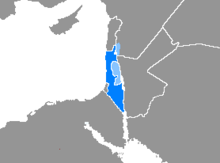Hebrew Language
| Hebrew | |
|---|---|
| עברית, Ivrit | |

|
|
| Pronunciation | [(ʔ)ivˈʁit] - [(ʔ)ivˈɾit] |
| Native to | Israel |
| Region | Land of Israel |
| Ethnicity | Israelites; Jews & Samaritans |
| Extinct | Ancient Hebrew extinct by 400 CE, surviving as a liturgical language for Judaism |
| Revival | 9.0 million speakers of Modern Hebrew of which 5 million in Israel. (2016) |
|
Early forms
|
|
|
Standard forms
|
|
| Hebrew alphabet | |
| Signed Hebrew (oral Hebrew accompanied by sign) | |
| Official status | |
|
Official language in
|
|
| Regulated by |
Academy of the Hebrew Language האקדמיה ללשון העברית (HaAkademia LaLashon HaʿIvrit) |
| Language codes | |
| ISO 639-1 | he |
| ISO 639-2 | |
| ISO 639-3 | Variously: heb – Modern Hebrew hbo – Classical Hebrew (liturgical) smp – Samaritan Hebrew (liturgical) obm – Moabite (extinct) xdm – Edomite (extinct) |
| Glottolog | hebr1246 |
| Linguasphere | 12-AAB-a |

The Hebrew-speaking world:
regions where Hebrew is the language of the majority (Israel)
|
|
Hebrew (/ˈhiːbruː/; עברית, Ivrit [ʔivˈʁit] or [ʕivˈɾit]) is a language native to Israel, spoken by over 9 million people worldwide, of whom over 5 million are in Israel. Historically, it is regarded as the language of the Israelites and their ancestors, although the language was not referred to by the name Hebrew in the Tanakh. The earliest examples of written Paleo-Hebrew date from the 10th century BCE. Hebrew belongs to the West Semitic branch of the Afroasiatic language family. The Hebrew language is the only living Canaanite language left.
Hebrew had ceased to be an everyday spoken language somewhere between 200 and 400 CE, declining since the aftermath of the Bar Kokhba revolt.Aramaic and to a lesser extent Greek were already in use as international languages, especially among elites and immigrants. It survived into the medieval period as the language of Jewish liturgy, rabbinic literature, intra-Jewish commerce, and poetry. Then, in the 19th century, it was revived as a spoken and literary language, and, according to Ethnologue, had become, as of 1998, the language of 5 million people worldwide. After Israel, the United States has the second largest Hebrew-speaking population, with 220,000 fluent speakers, mostly from Israel.
...
Wikipedia
